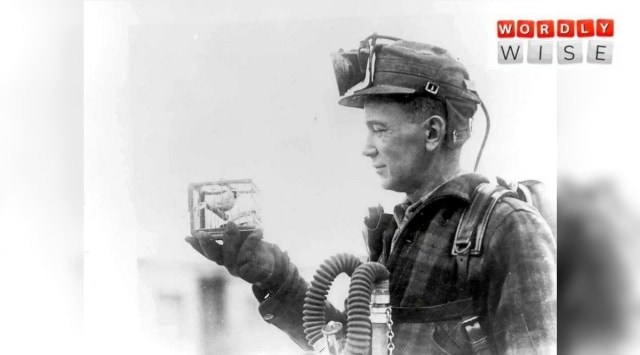From coal mines to English vocabulary: How a tiny bird became a lifeline for miners
With the coming of the Industrial Revolution, coal mines became deeper and deeper to meet the growing demand of fuel for industrial machinery. We explain how canaries became indispensable lifelines in the risky profession, eventually lending their name to a popular English idiom.
 Mining foreman R. Thornburg shows a small cage with a canary used for testing carbon monoxide gas in 1928. (Wikimedia Commons)
Mining foreman R. Thornburg shows a small cage with a canary used for testing carbon monoxide gas in 1928. (Wikimedia Commons) While going through an opinion piece in The Indian Express recently, I came across an interesting sounding idiom. Naturally, that set me out looking for the genesis of ‘canary in the mine’. And what a fascinating story it turned out to be!
Starting late 19th century till much of 20th century, tiny yellow canaries were the constant companions of coal miners – for, it was a matter of life and death! Here’s why.
As the Industrial Revolution gathered pace, steam engines started propelling ships and trains. Thus, with a rising demand for coal as fuel and some accompanying technological advancements, mines started going ever deeper. This also brought with it more mishaps, with explosions and poisonous gases leading to the death of miners and pit ponies, which accompanied them to haul coal.
Initially, it was believed that the mine deaths occurred due to the force of the explosions and burns. But Prof John Scott Haldane, a medical researcher and mining engineer researching mine deaths during the last decade of the 19th century, believed suffocation was the major killer.
Interestingly, one of the worst mine accidents that occurred in Tylorstown, Wales in 1896, while disproving his original theory, also led him to find the major cause of deaths in such cases.
Haldane, who went down to the Tylorstown mine pits, found that in a chamber where a few bodies lay there was an oil lamp still burning. This made it clear that suffocation due to lack of oxygen was not the main culprit because flames require at least 18 per cent concentration of atmospheric oxygen to burn whereas humans can survive with as little as 10 per cent.
A post mortem on the bodies revealed that a pink tinge on the bodies, which was earlier thought as marks of burns and bruises, was because of hemoglobin in the blood binding with carbon monoxide, a deadly gas which deprives the brain of oxygen.
For the next few months, Haldane remained locked in his gas-filled laboratory, testing the effects of carbon monoxide on himself and a number of smaller animals. His conclusion? While both mice and canaries were 20 times more susceptible to the gas than humans, canaries would give miners the best advance warning, as they stopped singing and would fall off their perch upon being exposed to carbon monoxide.
Thus, a new tradition started, with miners taking canaries in wooden cages to deep into the mines to alert them of the presence of any poisonous gas. From the British Isles, the practice subsequently spread to the US and Canada as well.
In fact, due to their unique ability to detect poisonous gases, canaries have also been used in warfare, with earliest mention of their used found in memoirs of soldiers from the First World War. They would be used well into the 21st century, including during the Gulf War, where they were codenamed ELVIS – Early Liquid Vapour Indicator System.
In 1996, the British government brought in a law to stop the use of canaries in mining. They were replaced by electronic carbon monoxide sensors. But well before that, they had already found a permanent perch in the English language. A ‘canary in the coalmine/mine’ is used to refer to early indicators of a potential hazard.
The tiny bird has lent its name to a few other expressions as well. To say like ‘the cat that ate/got/swallowed the canary’ means that someone looks very proud or satisfied about something he or she has done. For example: After finding a fault with her boss, she smiled like the cat that ate the canary.
When someone ‘sings like a canary’ it means the person tells everything he or she knows about a crime or wrongdoing to the police or authorities. For instance: During police interrogation the main accused in the bank robbery sang like a canary.
In American English, canary stands as a slang for a female singer in a dance band. Canary is also a sweet white wine of the Canary Islands resembling sherry. As an adjective, it is refers to the colour of a canary.
- 01
- 02
- 03
- 04
- 05






































